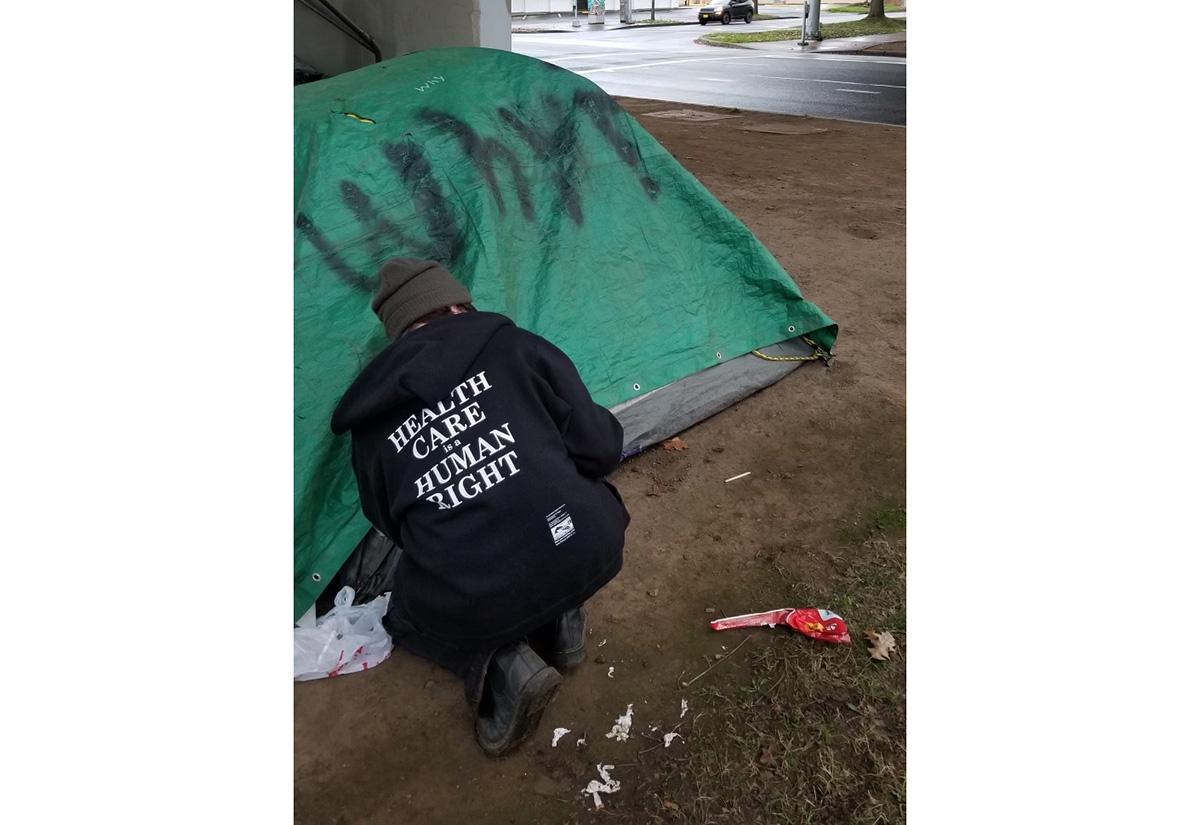
by Lesley Jo Weaver, Associate Professor, Department of Global Studies, and Mackenzie VanLaar, PhD, Department of Anthropology
Elsie, a woman1 in her mid-twenties who is struggling with opioid dependency on the streets of Eugene, Oregon, spiraled out earlier this year when police swept her camp, cutting her off from the mentor and friend she refers to as her “street dad.” “Like, my dad, my street dad—he’s somebody that really helped me,” she explains from the doorway of her tent. She begins crying. “Without him, now I’m crashing and burning even more because I can’t just go see him, you know what I mean? Some people are really, really big influences on what people do in their life—like, they make a huge difference.”
Just a few blocks away, Gigi, a non-binary opioid user who partially identifies as a woman in their late 30s, explains that they would never accept housing if it restricted them from visiting freely with their community. “The people that get apartments that are homeless—when they do finally get housing, they’re ridiculed [by neighbors] for having their friends over. It’s like…okay, so you just want them to go crazier, want them to obtain more mental issues, because now they can’t have the only support that they have come over and visit them? It’s so crazy. It’s like—I could not be housed and turn away my friends. Like, if I ever got the opportunity to be housed, I couldn’t say, ‘No, I can’t let you come shower.’ That would hurt me.”
As Elsie’s and Gigi’s comments illustrate, social relationships play a key role in people without housing’s (PWH’s) choices about where to sleep and what services to accept. Ultimately, those decisions have significant impacts on PWH’s health because they shape behaviors such as drug use. Homelessness is an extremely strong predictor of increased morbidity and mortality across all causes.2 Eugene, Oregon, is currently home to the highest per-capita homeless population in the country.3 As in other parts of the US, the housing crisis in Eugene has resulted in a population of PWH with an array of unmet health needs, many caused or exacerbated by the stresses associated with life without permanent shelter.4,5 In Eugene, the housing crisis had reached emergency proportions even before 2020 and was only heightened during the COVID pandemic, the catastrophic 2020 wildfires, and the nationwide political protests against police murders of Black people.
In summer 2022, with CSWS support, we conducted a series of exploratory interviews with 32 people involved in houselessness in Eugene, representing five major groups of stakeholders: women without housing, service providers, housed neighbors, elected officials, and other community leaders. Our goal was to lay the groundwork for a much larger study that will eventually help us better understand how to support health for women who cannot obtain access to housing in our community. While housing would be the ultimate solution for many, it will unfortunately be a long time before a sufficient quantity of low-barrier, affordable housing options are made accessible to our unhoused neighbors. In the meantime, we urgently need better ways to support women experiencing houselessness.
While our analyses are still underway, it’s already becoming clear that social connections with peers and mentors in homeless communities are key for women’s well-being. The experiences of people like Elsie and Gigi demonstrate that social relationships deeply impact health and even the degree to which PWH are willing to engage with supportive services. Many interventions designed to address homelessness or reduce its harmful impacts—such as transitional housing that prohibits visitors, inpatient addiction treatment programs that isolate individuals, and child protection services—force reconfigurations of social relationships for PWH. Our lack of knowledge about how those social disruptions shape health constrains evidence-based policy development and may ultimately thwart PWH’s efforts to obtain housing because existing social connections—tenuous and possibly harmful though they may be—are also the lifeblood that supports people like Elsie and Gigi.6 Therefore, solutions aimed at addressing houselessness must take into account the importance of community for PWH and must take seriously the preservation of social relationships whenever possible.
—Lesley Jo Weaver, Global Studies, received a 2022 CSWS Faculty Research project for this project. It was completed with the assistance of Mackenzie VanLaar, who graduated this year with a PhD in anthropology.
Endnotes
1 In our study, “women” refers both to women assigned female at birth, and to women not assigned female at birth.
2 Hwang, Stephen W. “Homelessness and health.” CMAJ 164, no. 2 (2001): 229-233.
3 HUD (US Department of Housing and Urban Development). “Continuum of Care Homeless Assistance Programs Homeless Populations and Subpopulations.” HUD, 2021.
4 Alexander, Adam C., Joseph JC Waring, Oluwakemi Olurotimi, Jasmin Kurien, Bishop Noble, Michael S. Businelle, Chaelin K. Ra, et al. “The relations between discrimination, stressful life events, and substance use among adults experiencing homelessness.” Stress and Health 38, no. 1 (2022): 79-89.
5 Byrne, Thomas H., Benjamin F. Henwood, and Anthony W. Orlando. “A rising tide drowns unstable boats: How inequality creates homelessness.” The Annals of the American Academy of Political and Social Science 693, no. 1 (2021): 28-45.
6 Tischler, Victoria, Alison Rademeyer, and Panos Vostanis. “Mothers experiencing homelessness: Mental health, support and social care needs.” Health & Social Care in the Community 15, no. 3 (2007): 246-253.

